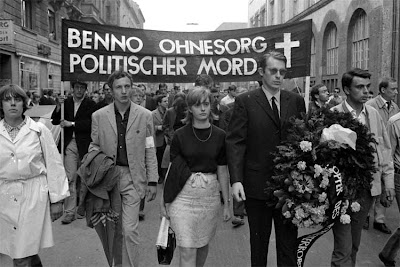
Bild, or the Bild-Zeitung, as it is sometimes called, is a hugely popular daily newspaper in Germany and in the opinion of some, a cause for national shame. It's the largest selling newspaper in Europe, but stories are often based on very thin evidence and headlines are always sensational. Stories in Bild are written at about a fifth grade level

and in many ways it would make ideal reading for someone like me who's language skills are less than perfect. But for a variety of reasons, not limited to the generous and sleazy cheesecake always featured just below the fold on page one, I can't even pick one up when it's laying unclaimed next to me on the streetcar.
Bild tends to polarize people in Germany. In a country that takes newspaper journalism very seriously, Bild seems an insult to the level of excellence established and maintained by papers like the Süddeutsche Zeitung, or the Frankfurter Allgemeine Zeitung. But more than that, Bild has a long history as a conservative paper that allows its editorial point of view to shape (and at times maybe create) the news. Into the 1980's, Bild, founded by Axel Springer in 1952, still referred to East Germany as the Soviet Occupation Zone and only began using the GDR official name a little later in quotes. When university student Benno Ohnesorg was shot and killed by Karl-Heinz Kurras, a West Berlin police officer during a protest against the visit of the Shah of Iran in 1967, Bild actively shaped public opinion against the student movement and supported the need for police to defend themselves with deadly force.

During the time of those protests, which were mirrored in countries around the world, including the US, where our own Kent State shooting has many parallels to the killing of Benno Ohnesorg, lines were drawn along traditional Right/Left boundaries. Student activists protested against the new capitalist government which was supported by the United States and, in the eyes of the students, was simply a neo-Fascist follower of the Nazi regime. At rallies and speaches, they often used the rhetoric of the East German state and the vocabulary of Marxism. As the movement developed over several years and the actions of a violent, radical splinter group of the student movement began to dominate headlines, groups like the Red Army Faction actually formed secret alliances with the German Democratic Republic in the East.
On the other side, police, members of the conservative and centrist middle class and the politicians they elected, all used anticommunist rhetoric to support actions against the protesters and back up the policeman, Kurras, who was tried for Ohnesorg's murder in two separate trials. He was seen as a champion of pro western Capitalism and cleared of all charges in 1970. He eventually reached the level of Detective Chief Inspector in the Berlin police department. He has never shown any remorse for his actions and in fact commented on them by stating that "anyone who attacks me is crushed" (Wer mich angreift, wird vernichtet. Aus. Feierabend. So ist das zu sehen.) By all accounts, he is an authoritarian type, not given to self doubt and a strong supporter of order and obedience. And last weekend it was announced in the German press that he was also a secret supporter of the East German State, a communist party member and Stasi agent. (Stasi = Ministerium für Staatssicherheit, the official secret police of East Germany.)
If this fact had been made known in 1967, it's unlikely that any of the left wing protesters would have believed it. More probably they would have assumed it were just another trick of the bourgeoisie neo-Fascists. But the facts are now clear, discovered by accident in the mountain of documents left behind by the fall of East Germany and the Stasi. Kurras, now in his 80's doesn't deny his membership in the party. So looking back, we can see that virtually all participants were allied with their own natural enemies and working at cross purposes to their own interests. The East German Communist party allied itself with radical activists to destabilize the West German government although they hated disorder and hippies and disobedience above all other evils. The students joined forces with the very people who were at least indirectly responsible for killing the left's greatest martyr. Western capitalists joined ranks and did everything in their power to unknowingly protect a communist secret agent. And with hindsight it's easy to see that the fight wasn't about socialism versus capitalism. The true battle front was running perpendicular to the one we were all watching so closely and the good news is, the good guys won, albeit completely by accident.
This story is still unfolding and the Stasi archives likely hold many more secrets, although it's hard for me to imagine any could top this revelation. There is no evidence to suggest that Kurras was acting under orders from his Stasi controllers when he shot Ohnesorg, but his actions contributed significantly to the speed and intensity with which the left wing student movement turned violent. Like the Reichstag fire in 1933 that Adolf Hitler used to solidify his power base, the Ohnesorg murder was a rallying cry for left. But the truth of the Reichstag fire is still unknown. In the case of Ohnesorg's murder, the truth has come out with the shock and certitude of a Hitchcock plot twist in the final frames of the film. Bild Zeitung is reporting on the story too, but with no mention of its former support of Karl-Heinz Kurras and certainly no apologies. I guess I didn't expect any.










1 comment:
that story reads like a movie script. One of those political thrillers with a confusing twist at the end.
Shawn B.
Post a Comment